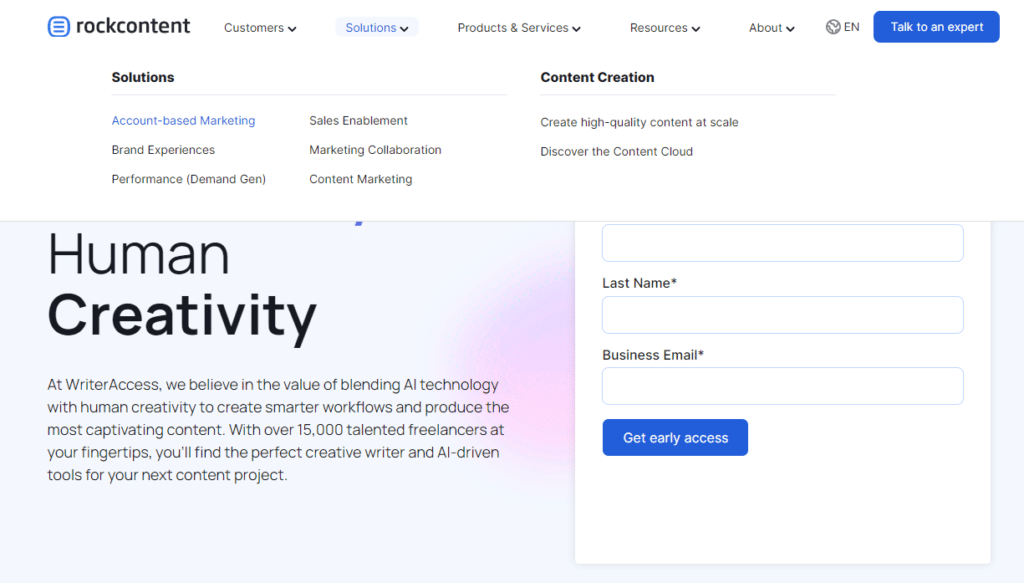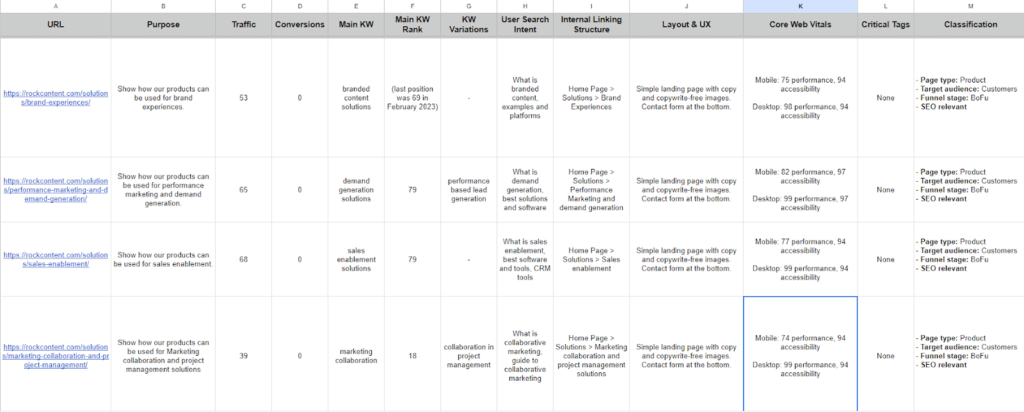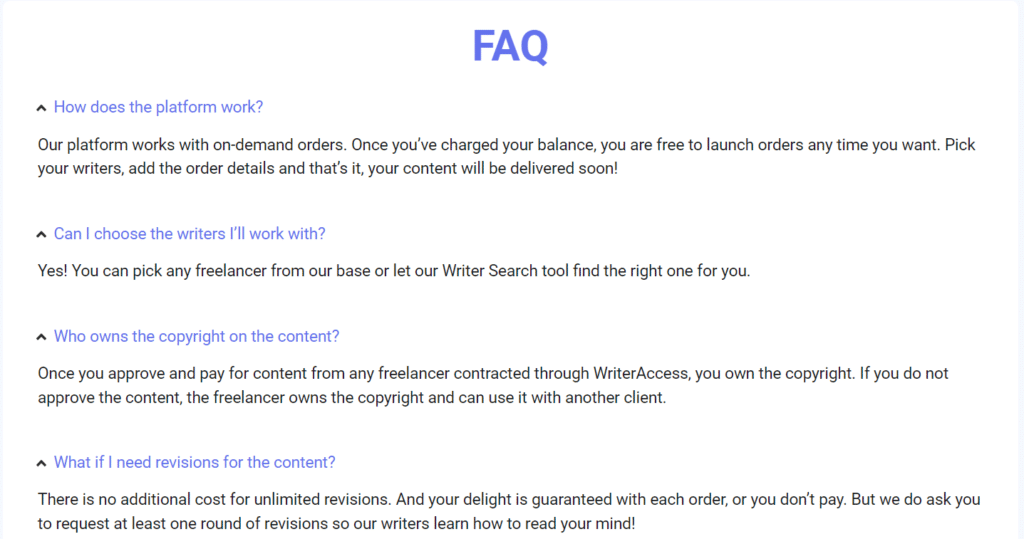Over the last decade, Rock Content has been an industry leader for content marketing and SEO for businesses.
Not only do we do extensive research and share new insights on these issues on a regular basis, but such tactics are also at the heart of our very own marketing efforts.
For a long time, our SEO focus was centered on increasing traffic in order to increase brand awareness and position ourselves as an expert in the marketing and content communities. In fact, our English website’s traffic increased by more than 80% in a year, with organic views per month growing from 166,000 in January 2022 to 301,000 in January 2023.

With such figures, it looked like it was time to shift our focus to the ultimate goal of any business: conversions.
Via thorough observation and analysis, our SEO team recognized that our top-of-the-funnel educational content, which had served us well for years, would not be sufficient for the new task of generating more conversions.
We recognized, like many other B2B SaaS firms, the need for optimizing our whole website, particularly our landing pages, in order to achieve better outcomes.
Here is a summarized rundown of how we’ve enhanced our landing pages to upscale our monthly organic conversions.
Traffic-Focused SEO Vs. Conversion-Focused SEO
Search Engine Optimization is often compared to a website’s gateway, serving as a storefront rather than a salesperson. While this analogy holds some truth, it falls short of depicting the full potential of SEO.
While conversion is a metric usually associated with growth strategies rather than SEO, the latter can also do more than just refer consumers to the homepage or blog.
It can be wasteful to increase traffic without minding what happens next when SEO has the potential to help guide users through the whole conversion funnel.
So, to decide whether to focus on traffic or conversions, every SEO strategist must ask themselves: are the users progressing toward their intended goals? Is the business ultimately benefiting from their actions?
Casting a Wide Net with Traffic-Focused SEO
Most popular on-page and off-page SEO techniques widely discussed on the web are often traffic-focused. It’s all about creating informative content with high-search-volume or high-ranking-difficulty keywords to reach a broader audience.
It is a sensible choice: every company needs people to visit the website before even thinking about turning them into customers.
We’ve been using this strategy at Rock Content for years, and it has produced remarkable results. Back in the early 2010s, our content not only played a crucial role in disseminating content marketing principles outside of the North American and European markets, but it also established our brand as a leading expert on the subject.
Our material is regularly cited throughout the web, our online academy certifications are highly valued in the corporate world, and our websites consistently attract hundreds of thousands of new and returning users every month.
This achievement was made possible through our commitment to publishing high-quality educational content regularly, staying ahead of industry trends, and fostering strong relationships with other brands. Not only did we improve the visibility of our content but also enhanced our rankings on SERPs.
But as our business grew larger, so did the need for a maturer and more qualified audience. That’s when we figured a more conversion-focused SEO approach needed to come in.
Nurturing and Guiding Visitors with Conversion-Focused SEO
A conversion-focused SEO strategy, as opposed to a traffic-focused SEO strategy, puts emphasis on optimizing the website to encourage users to perform a particular action, like completing a purchase, submitting a contact form, or subscribing to a newsletter.
The goal is to maximize the conversion rate by creating a seamless user experience and providing persuasive content that guides visitors toward desired actions.
At the top of the funnel, conversion-focused SEO focuses on attracting qualified traffic.
This entails targeting keywords that indicate high purchase intent or align with specific target audience segments.
By tailoring content to address the needs and pain points of these potential customers, websites can attract visitors who are more likely to convert.
As visitors progress through the funnel, the focus shifts to optimizing landing pages and user journeys to facilitate conversions.
This involves streamlining the conversion path, implementing persuasive call-to-action elements, and providing social proof and endorsements to build and increase credibility and trust.
Considering our history and new goals, our SEO team decided to embark on an experimental quest to further enhance our conversion potential organically.
Pushing Bottom of the Funnel Content Through Landing Pages
We had already been working with the CRO team to strategically include written CTAs and banners inside older and strategic pieces, as well as putting bottom-of-the-funnel keywords into our editorial calendar.
However, we understood that we needed to go one step further and work with our entire website, not solely the blog, and transform it into an organic conversion machine.
We conducted thorough research and benchmarking exercises, meticulously analyzing competitors and industry peers.
It soon became obvious that the most promising course of action for us to take was to optimize both our current landing pages and develop new ones in order to get higher ranks in SERPs and improve user progression through the conversion funnel.
That’s when our “Website BOFU Pages” project started.
Project roadmap
With this initiative, we aimed to increase the visibility and impact of our landing pages while tapping into their potential to boost conversions to our products’ free trials.
We kicked off the project by locating and optimizing existing landing pages that are relevant to SEO and customer conversions. Although we also acknowledged the freelancer-focused pages, we deemed them a lower priority for the time being.
To do so, we broke it down into three key stages:
- Mapping and categorization: The initial step involved mapping out all our existing landing pages and potential new pages, and categorizing them based on their relevance and priority.
- Content creation: With the pages categorized, we proceeded to evaluate each one’s optimization needs. This evaluation process enabled us to identify areas for improvement, develop a tailored plan to enhance their performance, and effectively optimize or create the pages.
- Tracking and analysis: The final action focused on implementing effective tracking mechanisms to closely monitor the conversion rates of the optimized landing pages, capture relevant data, and analyze the results.
Let’s delve deeper into each of these steps and understand how we navigated through this project.
Mapping and categorizing landing pages
To get started, we needed a comprehensive understanding of our landing page ecosystem.
Besides our main website, we have many mini-sites for our products, services and resources, which also require inspection and evaluation.
Here’s how we tackled this task:
1. Thorough examination of existing pages
We conducted a meticulous examination of every landing page within our digital domain.
We took the time to carefully go through each page, trying to understand its structure and purpose. We looked at things such as how the content was laid out, how people could navigate through the page, and what actions we wanted them to take.
Here’s what we took into account when assessing the pages:
- Purpose and relevance
- Performance (traffic, SERP position, and conversion rate)
- Search intent for main keywords
- Internal linking structure (click depth)
- Layout and UX
- Core Web Vitals
- Critical tags (noindex and canonical)

2. Research and benchmark for new landing pages
After completing our initial mapping of existing landing pages, we gained knowledge of our content gaps and identified opportunities for the creation of new pages.
By closely examining our competitors’ strategies and analyzing industry peers, we learned about the most effective keywords and content that we should focus on. This benchmarking served as inspiration and direction for our new landing pages, allowing us to structure information in a way that would resonate with our target audiences.
We conducted in-depth keyword research to optimize our landing pages for search engines and attract qualified traffic. We obtained a better knowledge of search intent and discovered unique pain points and demands of our buyer personas by utilizing tools such as Answer The Public and SemRush.
With our research findings, we were able to identify untapped market segments and emerging customer needs. We aimed to tailor our landing page content to successfully address these concerns, driving visitors toward conversion.
3. Classification and Prioritization
With the research done and relevant data in hand, we needed to efficiently select and allocate resources to ensure that our efforts were directed toward the most promising opportunities.
To do that we established a classification framework that encompassed various parameters, to organize, categorize and prioritize the landing pages effectively.
We used the following criteria for classifying the pages:
- Page type (product, service, resources, form, brand)
- Target audience
- Funnel stage
- SEO-relevant vs. brand-relevant

By considering factors such as their alignment with SEO objectives and their impact on customer conversions, we were able to identify which pages held greater significance and deserved immediate attention.
To decide which pages we needed to tackle first, we considered the following:
- Current performance
- Conversion potential
- Traffic potential
- Ranking potential
- Strategic relevance
- Stakeholder priorities
- Competitor analysis
- Resources and timeline
Creating and optimizing landing pages
With our pages’ assessment in hand, it was time to move on to the stage of optimizing our existing landing pages and creating new ones.
Creating a detailed content strategy, preparing the page structure and design, optimizing for search engines and user experience, and integrating analytics tracking for reliable performance measurement were all part of the process.
Developing Content Strategy and Copywriting
We meticulously designed a content strategy targeted to each landing page’s individual goals, target audience, and keywords to assure its success.
We aimed to develop captivating content that would connect and drive visitors to take action by matching our messaging with the requirements and pain areas of our audience. Meanwhile, we also wanted the content to also be optimized for search engines and rank high in the SERPs.
For instance, consider the following landing page we built from scratch.
We learned that the keyword “blog writing services” had the potential to efficiently fulfill all of our goals, hence driving qualified traffic and boosting conversions. It is also well aligned with a few of our buyer personas (i.e. marketing agencies, content marketing analysts, and small companies) and objectively depicts one of our best-selling services.
Throughout the entire page, the copy raises awareness of potential issues that these services can solve or goals they can help the personas achieve. It talks about increasing traffic, producing higher-quality content faster, working with professional writers, and so on.
We present a problem and its solution in more than one way over the course of the page.

Planning Page Structure and Design
A user-friendly and aesthetically appealing page structure is as essential as captivating copy for a positive user experience and good conversion.
By organizing the content strategically and creating an aesthetically pleasing design, we aimed to engage visitors and guide them towards the desired conversion goals.
We already had a layout template for landing pages that we decided to reuse for the majority of new pages we created during this project. With new engaging images and a few tweaks, we managed to fit the design into the page’s proposition.
Doing so also helped to speed up the production and optimization workflows as we did not depend on a web developer to help us implement changes and create new pages.
Using the same “blog writing page” as an example, we created a FAQ section that differs from other pages. This part was inspired by a handful of the websites we benchmarked earlier, and we opted to incorporate it since it allows the user to make a faster,more educated decision to accept the CTA, which in this case is WriterAccess’ free trial.

Moving Forward: Monitoring Performance and Analyzing Results
Pages are now published, but there is no SEO without analytics. Accurate tracking of the pages’ performance is key for evaluating the effectiveness of landing pages and making data-driven decisions.
The KPIs and metrics will vary depending on the predetermined goals for the landing pages, but in our case, we kept an eye on:
- Page views: The traffic volume the page is bringing.
- Traffic source: Where the users are coming from. With UTM tags you can track if your traffic is coming from organic search, referral, or email marketing, for example.
- Conversion rate: The number of times the page’s CTA is being followed. If you have more than one step in the conversion funnel as we do, it’s important to determine which step will be accounted for as conversion. For comparison, top websites have a conversion rate of 11%.
- Bounce rate: The number of visitors that leave the website after seeing only one page. This KPI is interesting to reflect if the page is accurately matching the search intent for its keywords, if it’s generating curiosity, or if it’s lacking information for a faster decision-making process.
- Heatmap: This one isn’t essential, but definitely helpful. Learning where your users are clicking and what they’re missing on the page offers valuable insights for further optimization.
There are many robust tools that can help you monitor the key metrics. Here, we used Google Analytics to track traffic, SemRush and Google Search Console to monitor page and keyword ranking in the SERPs, and Hubspot to get a better understanding of our conversion goals.
From now on, we have to include the new pages in our internal linking workflows and make sure that there are no broken links coming from the old optimized pages. We will also boost our outreach efforts to get backlinks for these pages and improve the stakes of getting them ranking high on the SERPs.
It’s old news that the job is never really done when it comes to SEO, but now it’s time to let it work its magic while we closely monitor the performance of each page.
Do you want to continue to be updated with Marketing best practices? I strongly suggest that you subscribe to The Beat, Rock Content’s interactive newsletter. We cover all the trends that matter in the Digital Marketing landscape. See you there!







